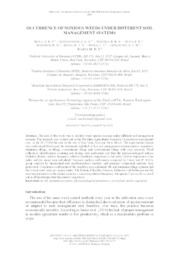Occurrence of noxious weeds under different soil management systems.
Occurrence of noxious weeds under different soil management systems.
Author(s): MELO, A. K. P.; ALBUQUERQUE, J. A. A.; SIQUEIRA, R. H. S.; SILVA, E. E. da; MEDEIROS, R. D. de; SOUZA, K. T. S.; SOUZA, L. T.; GONÇALVES, A. C. M.; SOARES, M. B. B.
Summary: The aim of this work was to identify weed species in areas under different soil management systems. The research was carried out in the Brazilian Agricultural Research Corporation experimental area, in the 2017/2018 harvest, in the city of Boa Vista, Roraima State, Brazil. The experimental design was randomized blocks and the treatments included of five soil management systems (native vegetation, minimum tillage, no-tillage, conventional tillage and conventional tillage with crop rotation). Weed collection, identification, counting and drying were performed and then the phytosociological indices (Relative density, relative frequency, relative abundance, importance value index, relative importance value index and dry mass) were calculated. Variance analysis with means compared by Tukey test (P <0.05), group analysis by hierarchical and non-hierarchical method, and principal component analysis were performed. Correlation coefficients of the variables were estimated. No and minimum tillage systems had the lowest weed rates per square meter. The botanical families Poaceae, Fabaceae and Rubiaceae are the most representative in the studied systems. Concerning relative frequency, the species Cyperus flavus stood out in all treatments other than native vegetation.
Publication year: 2021
Types of publication: Journal article
Unit: Embrapa Roraima
Observation
Some of Embrapa's publications are published as ePub files. To read them, use or download one of the following free software options to your computer or mobile device. Android: Google Play Books; IOS: iBooks; Windows and Linux: Calibre.
Access other publications
Access the Agricultural Research Database (BDPA) to consult Embrapa's full library collection and records.
Visit Embrapa Bookstore to purchase books and other publications sold by Embrapa.

